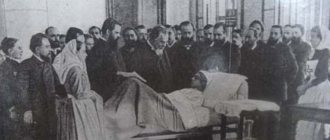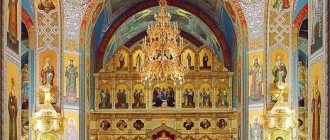Being interested in the question of what a church parish is, first let’s figure out how it differs from a temple. People often use the words “parish” and “temple” as synonyms, but there is still a difference between them. It is believed that a temple is simply a building for religious purposes, and a parish is made up of people who come to the temple, who are called parishioners. And they make up a whole community. What a parish is is explained very well by the Gospel, which contains the following words spoken by Jesus himself: “Where two or three are gathered in My name, there I am in the midst of them.” This suggests that people go to church for worship to communicate with the Lord and with each other.
What are parishes?
The definition must be sought in history. Let's try to figure out how parishes arose and what contributed to this. Let's start with the fact that until 313, Christianity was banned on the territory of the Roman Empire. True believers gathered secretly for services in separate places - in caves or houses.
After the end of the persecution, ancient Christians began to refurbish and consecrate former pagan temples for their services. In this way, the very concept of a parish gradually emerges as the primary structure of the Church and a form of self-organization of church life.
About the norm of parish life
The experience of missionary work and catechesis indicates that the most beneficial churching of youth occurs in parishes whose life includes:
- Weekly communion for community members.
- Temple and home prayer for each other.
- General parish conversations with the rector, taking place in an informal setting.
- The rector's visit to parishioners (due to his spiritual fatherhood).
- Material support and social assistance to those in need, care for parishioners who are unable to come to church.
- Joint pilgrimage trips.
- Joint work of parishioners and clergy to improve the temple.
- Family-type Sunday school, where, if possible, taught by clergy and parishioners of the temple.
- A parish kindergarten on weekends (during divine services), run by parishioners who have experience raising small children.
- A youth club that would provide friendly and prayerful communication among young members of the parish.
- Parish mutual aid fund.
- Non-liturgical prayer meetings of parishioners with reading of the Holy Scriptures in small groups.
- Missionary and social activities of community members.
- Parish library.
- Active performance by community members of administrative and economic functions in accordance with their competence and abilities.
- The performance of the Sacraments of the Church is required exclusively for donations, and not at a set rate, voluntary “tithe” for the needs of the temple and the maintenance of the clergy, adequate payment for the labor of the temple workers, which takes them a lot of effort and time.
Who is a parishioner?
The Bible says that the Church is the mystical body of Jesus Christ, and the parish is a cell of one large organism. A truly believing person should feel his involvement in the Universal Church precisely through such a community. This participation is mainly carried out through the sacrament of the Eucharist, where the transformation of bread and wine into the Body and Blood of Christ takes place (through these holy gifts the Orthodox are united with the Lord), and through Him there is unification with the entire Universal Church. The very understanding of “being a Christian”, first of all, includes participation in the sacrament of the Eucharist.
Principles of relationships between clergy and laity
The basic principles of the relationship between the rector and the church community can be defined as family, brotherhood and fatherhood, expressing love and trust between all members of the parish, both priests and parishioners. In spiritual terms, the ideal situation is when the rector and other priests of the parish are the spiritual fathers of the parishioners. On the other hand, parishioners and priests must observe a certain subordination in their relations with each other, since one can often find cases of distortion of the principle of paternity, for example, the “friend-foe” relationship model or the elitist self-awareness of a particular community. It is necessary to understand that such relationships are sometimes nurtured and provoked by the priest himself.
It should be noted the importance of the parishioners’ obedience to the priest due to his conscious choice as a spiritual leader (in the area of personal spiritual life), as well as due to the status of the priest’s ministry (in the area of doctrinal and administrative). At the same time, the priest is called to remember that the laity in their fullness represents, according to the Apostle Peter, “a royal priesthood, a holy nation” (1 Pet. 2:9). Therefore, it is desirable for the entire parish to participate in making important decisions related to the life of the community.
The fatherhood of the priest in relation to the parishioners is expressed in primacy in love, active participation in all affairs of the community, as well as in teaching, spiritual guidance and sacramental service. A parish is a family, and all members of this family, especially those carrying out pastoral service, are called to actively participate in the life of the community. The role of the priest only as a fulfiller of demands or a cult “mediator” between the people of God and God is unacceptable - parishioners expect a living and active participation in the life of the community from the pastor.
Divine service
You can come to church every day, stand at the service and participate in the sacraments, not forgetting about yourself and your salvation, as well as the salvation of your relatives, but you cannot remain indifferent and not be interested in what is happening in your community.
It is difficult to call such people members of a parish or community. A true member will be one who recognizes community life as a common cause. This is the Liturgy, which is not only part of the liturgical circle, it includes everything: church services, missionary work and charity.
In the question of what a parish is, it should also be noted that a parish is not something separate and self-sufficient, it must necessarily be closely connected with the Church.
Parish as a social group
The article gives a general idea of the parish in the Russian Orthodox Church as a social group and a structural organizational unit of the Church.
Key words: parish, parishioner, church (temple), group, community, social, organization
Some behavioral patterns of people’s activities and their psychological characteristics, such as the value orientation of the individual, motivation for activity in a particular area, etc., are partly determined by the factors of inclusion of people in various social groups. They exist in any stable society, varying in size, content and significance. In our case, we consider a parish (parish community) as a social group or organization.
The closest and most understandable, socially tangible expression of the Church for a simple believer is a parish headed by a priest-rector. Speaking about the parish as a significant part of the Church, uniting a group of people with certain goals and objectives within the framework of parish life, we can also talk about the fact that the parish community acts in society as a social group. In the context of the administrative-hierarchical structures of the Church, we can talk about a parish as an organization. V. Legoyda notes that the Church, at a superficial glance, has some external signs of a corporate organization, but internally it exists according to completely different laws. A person can leave any organization of his own free will if something does not suit him there, but the Church, in principle, is built on completely different foundations than corporatism; people don’t just leave it [see. 6, p. 4], belonging to the Church is created at an ontologically deeper level, but, speaking in the language of secular sociology, when it comes to a parish (parish community) and its external forms of expression, it can be spoken of as an organization. The institution of the Church at the parish level expresses itself in parish communities. A specific churchgoer today has the right to find for his spiritual self-realization in the Church the parish that will be most favorable for the spiritual development of his personality, and in the search process he can change several parishes without leaving the Church as such.
The personal exponent of church unity and its connections is the bishop (bishop). During the formation of Christianity, each local community was headed by a bishop, and over time
“societies arose that were branch communities in relation to the bishop, the management of which was given to persons of lower hierarchical degrees, that is, to priests. The parish represents a part of the “local Church”, its specific Eucharistic meeting. Due to numerical and spatial growth, the Eucharistic community was divided into many Eucharistic assemblies” [2, p. 17–18].
Today, the general structure of the Church organization in Russia (and some other regions ecclesiastical subordinate to the Moscow Patriarchate) is regulated by the Charter of the Russian Orthodox Church (ROC), according to which there are several levels:
- Patriarchate (headed by the Patriarch), under which there is a Synod consisting of several bishops.
- A diocese headed by a bishop.
- Diocesan institutions, deaneries, parishes, monasteries and other organizations located within a particular diocese.
The ruling bishop in a particular diocese is the head in relation to the parishes of the diocese. In the liturgical context for a parish, episcopal primacy consists of blessing and issuing an antimension[1] to the rector of the church, which guarantees the celebration of the Liturgy in a particular parish church, as well as the ordination and appointment of clergy. Raising the name of the ruling bishop during services serves as a canonical sign of the parish’s affiliation with a specific “local Church.”
Within the framework of our given field of study, the lower level of the church structure will act as a socially significant organizational unit - a parish that spiritually realizes itself in the Eucharistic parish community[2], headed by a rector. The diocese today, to a greater extent, acts as an administrative body of the Church, and it is the parish for the ordinary believer, as a rule, that is the only really visible, experiential, living reality of the Church. Not only administratively, but also spiritually and mystically, the parish is part of a larger unity, and in unity with other parts it can live in the fullness of the Church [see. 14, p. 182]. According to the modern Charter (Art. XI, 1),
“the parish is a canonical division of the Russian Orthodox Church, is under the supervision of its diocesan bishop and under the leadership of the priest-rector appointed by him” [13].
So, we have decided that a parish within the scope of our interest can be spoken of, on the one hand, as an organization that outwardly expresses one of the structures of the Church (the lower level), and on the other hand, as a social group within society. In social psychology, the term “organization” is often used “in a technical sense, that is, in the sense of a social unit or group of people created to achieve certain goals” [11, p. 40]. It is in this sense that we consider it legitimate to use the concept of “organization” in relation to the parish.
Considering modern models of metropolis parishes, we will conditionally divide them into two categories (it is worth noting that such a division is not provided for in any way by the Charter of the Russian Orthodox Church). Presumably, we can talk about the organization of parish life in churches according to the type of cathedral models, such as, for example, the Kazan Cathedral, St. Nicholas of the Epiphany or Preobrazhensky, which differ in the nature of their daily existence from small parish churches. The allocation of the cathedral type of parish into a separate category, in contrast to the communal (or missionary-communal) type, was proposed at one time by Archpriest. Georgy Kochetkov [see. 7, p. 102–103, 119].
The organization of parish life on the model of traditional cathedrals presupposes the presence of a significant staff of clergy, a fairly rigid and clear structure of intra-parish management and, as a rule, a more tangible distance between clergy and parishioners. Often in such churches the parishioners do not know each other well; the clergy, choir and parishioners exist largely autonomously. Usually churches of this type are open every day and are more visited by people who come into the temple to be curious, light a candle, but they may not be present at the services. It is difficult to consider such people as parishioners, but a considerable part of the temple’s income comes from precisely such “parishioners.” In cathedral-type parishes, a person who visits church several times a month most often does not feel like a full member of the parish and an active participant in its life. He is “a client in a funeral service plant... he has no rights, he bears no responsibility,” the abbot noted. Innokenty (Pavlov) [7, p. 26]. The Church, of course, must have cathedral parishes that function every day, the main golden quality of which is openness to everyone at almost any time. But, unfortunately, in many temples the performance of rituals is carried out on the principle of service for the provision of certain services. When conducting surveys of parishioners of various churches in St. Petersburg (the study was conducted by the author), 40% of the 400 respondents responded that demands were fulfilled in their parish only if they were required to be paid. Patriarch Alexy II (Ridiger) repeatedly spoke on this issue in his official addresses to the clergy [see. 10].
The church-social environment created today is in many ways formative for a believer. Certain stereotypes and attitudes, some necessary ritual of behavior are formed by this very environment into which a person plunges when he comes to church. According to the psychosocial theory of personality development by E. Erikson, ritualization is characteristic of human nature and, to one degree or another, acts as one of the needs of the individual. In its negative manifestation, it turns into blind religiosity, magic and legalism, taking the form of playing roles that ultimately do not reflect the highest needs of the human personality [see. 5, p. 185]. Today, a creative, living revival is needed in the life of the parish. Every parish should be missionarily open to everyone, while at the same time having its own boundaries and membership, responding lively and creatively to needs, and not simply adapting to the circumstances of modern reality or following the “letter of the law”, and sometimes unwritten rules. It is rightly noted that a person who today wants to serve God and the Church strives to go to a monastery or receive holy orders, which indicates that, despite external freedom, people do not find the opportunity to have their point of application in parish service when they are laymen . Many people simply left churches, not meeting their expectations and not receiving consolation in their spiritual quests by coming to Orthodox churches [see. 7, p. 39–40].
“For many Orthodox people, the concept of parish and the concept of community are not completely identical <...> the communities we know today in the church are not what the parishes are in it, in many ways they are even opposite,”
- notes priest Georgy Kochetkov [7, p. 90–91]. Take, for example, a parish as a collection of believers who pray together in church every Sunday and on major church holidays. In such a meeting it is not necessary to establish contacts with each other - I prayed, “spent” my spiritual needs and returned to everyday affairs. From year to year, especially in large churches, you may notice familiar faces, but never make contact with them. The disunity is obvious. But if the parish is something more, then there must be some kind of life in the context of communication and social connections between members of the community and participants in prayer meetings. And here, not only the personality of the rector is important, but also the initiatives of the parishioners, and the general church orientation toward creative, meaningful, purposeful parish life, which is currently very weak in many cases. One of the reasons for disunity can be called the strong, sometimes even painful, social stratification of people, their belonging to different social and cultural groups in society, as well as the fragmentation of their areas of interest, which may not be directly related to the activities of the parish.
Speaking about a certain imperfection of the modern parish, A. Rogozyansky [12].
Russian sociologist S. Lebedev, reflecting on the problems of parish life today, notes that even outwardly churchly, completely religious Orthodox people
“in many cases they begin their church life not with traditional religious socialization... but in a complex and “roundabout” way. The seeds of religious Orthodox culture can be planted in a person’s soul through literature, the media, informal communication, education and other channels of communication, and this moment is often difficult to trace” [see. 15].
It often happens that
“Even having come to consciously Orthodox religious beliefs, a person does not always “automatically” become a church member. But even after becoming a church member, he can limit his church life mainly to cultic activity: regularly going to church, confessing, receiving communion, reading soul-helping literature, even communicating with his confessor, without participating in any joint activities with other parishioners outside of divine services.” [15].
At the Moscow Diocesan Meeting, His Holiness Patriarch Kirill repeatedly pointed out the importance of proper organization of the life of the parish community:
“Those who work in the church should feel needed by the parish and realize their abilities to the fullest. Among them there should be people capable of becoming the initiators of important parish affairs” [2].
The Patriarch emphasized the need to actively involve church-going Orthodox families in the life of the parish. Benevolence, leniency and sensitive attention towards people coming to church should be a manifestation of the missionary responsibility of any Christian, said the Patriarch [2]. According to M. Shilkina, community life in the parish should be such that everyone new to the parish is helped by people who have already grown spiritually in the parish, who can help a person relieve the tension that arises between his presence in the world and the craving for spiritual life. And the more developed the community spiritual and social life of the parish is, the easier it will be for a person to firmly and consciously strengthen himself in the Church and at the same time cope with the problems that lie in wait “in this world” [see. 7, p. 220–221].
The social and missionary orientation of a particular parish can develop in different directions, while it is impossible to do everything efficiently at once, and therefore one should choose a priority direction for the non-liturgical activities of the parish, in accordance with its capabilities, without forgetting about other aspects of the parish’s development. When choosing the area of active activity of the parish community, one cannot fail to take into account the location of the church, the financial and content capabilities of the parishioners. In developing the theme of qualified missionary openness of the parish, the Council of Bishops of the Russian Orthodox Church in 2011 indicated
“on the need to intensify work to introduce full-time paid positions of teacher, social worker and person responsible for working with youth in parishes of the Russian Orthodox Church. At the same time, taking into account the inevitable difficulties in implementing this decision, at the first stage these positions should be introduced in large urban parishes” [9].
When observing the real life of parishes, a certain “lack of demand” among parishioners is sometimes noted:
“They are not involved in the management of the parish and are deprived of participation in discussing the problems of parish life and practice. Removed from church initiative and creativity... The personal qualities, skills and capabilities of parishioners are not involved in parish and diocesan practice. The temple and clergy see in them only the source of their material content” [1, p. 112].
According to the current Parish Charter of the Russian Orthodox Church, only 10 people are canonically significant for the parish (and then very conditionally), the role of the remaining parishioners is humiliatingly reduced to only the following:
“Every parishioner has the duty to participate in divine services, regularly confess and receive communion, observe the canons and church regulations, perform works of faith, strive for religious and moral improvement and contribute to the well-being of the parish. It is the responsibility of the parishioners to take care of the material maintenance of the clergy and the temple,”
- says the Charter of the Russian Orthodox Church (Article XI, 32–33) [13].
No rights - only responsibilities! Almost the same can be seen in the relationship between parish clergy and the ruling bishop. The archpastoral sacramental function of the ruling bishop is focused on the ordination of clergy and the consecration of churches, and his administrative and canonical right as Primate is expressed in the appointment, transfer and, if necessary, prohibition of clergy, thereby the ruling bishop is perceived rather as the head and superior of the clergy.
In church life, we have long been accustomed to the negative connotation in the word “layman,” i.e. worldly, located “in the world.” This is someone who is only capable of passive perception, he has nothing functional to do in the Church other than monetary donation, since he has no ministry, no charisma. Thus, the ordinary believer remains, as it were, outside of church service, which contributes to the clerical pushback of ordinary “faithful” from more active participation in the life of the parish.
“Parishioners act as extras, whose duty to attend the service is in no way balanced by the right to participate in decision-making related to their parish...”,
- notes N. Mitrokhin [8, p. 221].
In fact, the direct creative participants in church and parish life should be not only the clergy and members of the parish meeting, the role of the majority of whom is often formal, but also the permanent parishioners who form the backbone of the parish. A parishioner must have his own degree of active participation in the life of the parish - this must be his honorable right and duty. Of course, it is important to draw a line between regular parishioners and the so-called “parishioners,” whose degree of participation in the affairs of a particular parish can, until some time, be considered illegitimate. In view of the above, we note that a significant part of ordinary church employees and parishioners, as a rule, do not consider themselves to have the right or feel the opportunity to influence the organizational culture of the parish. According to studies conducted in St. Petersburg, in cases of various violations of church ethics and abuse on the part of parish leaders, about 70% of parishioners surveyed in different churches simply will not tell anyone about it and (or) will try to move to another church. The survey also shows that a considerable part of the staff and parishioners of parishes in St. Petersburg are ready to accept various ritual rules, without understanding their true meaning and their relevance in modern church life[3].
From a legal point of view, today in Russia the parish community is registered with the relevant regional bodies of the Ministry of Justice by submitting a list of the parish council, consisting of at least 10 people. However
“The co-founders of the community actually enter the parish council only at the first stage. In the future, they may be replaced, die, or stop visiting this temple. From the point of view of the law (both state and church), the main thing is that the community is registered, but whether it retains its previous composition, whether self-government bodies will actually operate there does not matter” [8, p. 36].
The Charter of the Russian Orthodox Church (Art. XI, 25) states that “members of the clergy may be moved and dismissed from their places by the diocesan bishop at a personal request, by church court or by church expediency” [13]. That is, the clergy (clergy) are somewhat dependent on the ruling bishop, and ordinary parish workers are in an independent position on a diocesan scale, and their “place in the sun” is actually determined based only on the chosen form of relationship with the parish rector.
As can be seen from the above, the dependence of the clergy on the diocesan leadership is quite strictly emphasized in the Charter with the wording about the possibility of moving and dismissing from their places “for ecclesiastical expediency,” which gives the ruling bishop the opportunity to manipulate personnel as he pleases. Priest Pavel Adelgeim rightly noted that
“The Charter defines the general principles of church life. They sprout in different colors. Each gardener organizes a flowerbed or bouquet according to his own taste - in each diocese, general principles acquire individual characteristics" [1, p. 6].
This can also be said about the organization of activities in the parish. Eg,
“with the formal uniformity of liturgical activities, the parishes of the Russian Orthodox Church, even within the same diocese, can demonstrate amazing diversity...” [8, p. 66].
In an address to the diocesan meeting of Moscow in 2005, Patriarch Alexy II noted that
“A selfish priest tries to tie a person to himself, to make him dependent, subordinate, spiritually enslaved. Pastoral feat, based on love, is replaced by spiritual manipulation, cold, imperious management of people... The confessor must teach his child to be free, to have clear ideas about spiritual life, and to be responsible for his moral choice” [10].
The condition for the full development of personality is the internal freedom of a person. Freedom is the main Christian and universal value. Therefore, any attack on her is an attack on human dignity. We can see the suppression of human psychological freedom in the activities of destructive religious organizations, the goal of which is to subordinate the consciousness and will of their adherents to the selfish motives of “spiritual leaders.” However, we may encounter examples of the enslavement of a person’s spiritual freedom in the activities of traditional Christian religions, although the theoretical goal of the True Religion is precisely that through communication with God a person can gain true freedom. When the principle of Christian teaching about the freedom of choice of a person is violated, the basic principles of building church life are also violated and the threat of turning the church community into a marginal organization becomes quite real.
External revival of parishes is sometimes initiated from above by authoritative instructions and directives with a recommendation to account for the work done. At the parish level, these are instructions from the rector on certain aspects of the life of the parish, which often occurs without detailed consideration of the possible costs, forces and capabilities of subordinates. The unreasonableness of such orders can be hidden behind the pious concepts of “obedience,” “humility,” and “blessing.” Unquestioning obedience to the abbot is sometimes presented as the height of virtue, and irresponsible experiments with human destinies can end sadly.
“Replacing my will with the will of a bishop or confessor <...> preserves the value of personal achievement, but does not relieve me of responsibility for my personal fate, and from the rector for the fate of the parish. <…> To obey means to trust. Therefore, obedience is a feat. Trust always comes with the risk of being deceived. When speaking about obedience, conditions are usually presented only to the novice, as if obedience expresses not a mutual, but a unilateral act. The first condition of obedience is the faithfulness of the mentor. He must be trustworthy."
- notes priest Pavel Adelgeim [1, p. 161]. In reality, it happens that “obediences” (assignments) are offered, regardless of the heart’s disposition and capabilities of the person being obeyed; in the parish, as a result, an environment is created as if everyone owes something to the parish and the leadership, and the parish environment can develop in such a way that it will even contribute to the aggravation of intrapersonal conflicts.
In this context, the category of responsibility is very important, both on the part of the leadership and on the part of all participants in parish life. In essence, each participant in parish activities assumes certain obligations. At the same time, it is important for everyone to be realistically aware of their own capabilities and the responsible degree of their participation in a particular matter. Hegumen Evmeniy (Piristy) very clearly and very precisely distinguishes in our activities duties that may not be reminded at our place of service (for example, a sexton must light the lamps in the altar and light the censer in a timely manner at the beginning of services), and assignments as tasks, additionally offered to us by leadership (for example, asking the deacon to help sweep the area near the church, whose responsibilities clearly do not include this). It is not enough to just fulfill duties; you need to be able to successfully carry out assignments, which undoubtedly helps in personal, professional and spiritual growth. But the problem arises when assignments begin to exceed the subordinate’s capabilities, which ultimately leads to a more irresponsible attitude not only to assignments, which the person simply seeks to avoid, but also to his immediate responsibilities. We should not transfer the entire burden of responsibility to the leader; our personal attitude to the assignments offered to us is very important - a choice arises:
“perceive an assignment as a problem or as a task . The difference between these two concepts is that the problem requires some kind of effort, some kind of crisis is implied. The task has a connotation of hope, an understanding that what we must do depends on us” [4, p. 40].
That is, in the first case, we will act more hastily and carelessly, and the assignment we accept will bring “sadness in the heart” and “languor of spirit,” and in the other, we devote ourselves to the assigned task with a greater degree of enthusiasm and creativity.
Unfortunately, people sometimes become manipulative material in the hands of “ugly” leaders. But in practice there should be no substitution of the actual hierarchical conciliar unity of the Church
“discipline based on orders, autocracy and enslavement. <…> Church discipline must have as its boundary the conscience of the cleric...” [4, p. 173].
As noted in studies of organizational loyalty,
“the application of strict organizational measures to employees will not contribute to the growth of corporate culture and voluntary activity of employees in the interests of the organization” [3, p. 35].
Unfortunately, the parishioners themselves often provide a reason for manipulating them, sometimes being under the influence of a distorted spirituality - they are utilitarian-oriented, with a religious-magical perception of the priest, from whom “infallibility” and “absolute” spiritual knowledge supposedly emanate. There may be a desire, avoiding responsibility, to find one’s hope “in the blessing right hand of the priest.”
When creating a parish community, one should avoid the danger of making the parish an organization that will reflect the formal implementation of the schemes for organizing parish life set by the Charter and the hierarchy (with certain staffing units, directives, schedules, etc.). When trying to get away from formalities, it is important not to turn the parish into some kind of spiritual unit of society, such as a social club for people interested in Orthodox culture, providing them with psychological support. A healthy community parish life has two components - two “components of success” in the life of the parish [see. 7, p. 238], which must have a harmonious, balanced development, from which the parish is formed as a community, which is a solid bond of the Catholic Church.
The socio-pragmatic component, which includes the socio-economic state of the community, joint work, acts of mercy, mutual assistance, psychological factors, etc. (the outer part of the iceberg that the community represents). In this aspect, social, educational, and external missionary activities take place. Here parish conciliarity (not replaced by democracy) should manifest itself with real membership in the parish and due responsibility for its parish.
The spiritual and liturgical life of the community, which is in a sense intimate and is comprehended in the personal experience of spiritual and prayerful participation in the life of the parish community. In this aspect, one can consider the understanding of worship, the frequency of services, liturgical singing, the decoration of the church, the openness of the service and the degree of active participation of parishioners in it (for example, general singing with the people), the practice of confession, communion and performing services, holding agape, personal prayer rules and asceticism.
Nachalo magazine No. 34, 2021
[1] An antimension is a rectangular board, consecrated and signed by the bishop, which is placed on the altar on the altar, and on which the Liturgy is celebrated; a particle of the relics of some holy saint is sewn into it.
[2] The Eucharistic community is the totality of persons serving the Liturgy in the church, which includes altar servers, singers, and all parishioners participating in the liturgical life of the church.
[3] The survey was conducted in the parishes of St. Petersburg by priest Alexei Kozoletov in 2006–2007. for the final qualifying work on the topic “Ways of forming beliefs in religious associations” at the St. Petersburg Academy of Postgraduate Pedagogical Education (the work has not been published).
Literature:
- Adelheim P., priest. Dogma of the Church in canons and practice. 2nd ed., add. Pskov: B.I., 2003.
- Report of His Holiness Patriarch of Moscow and All Rus' Kirill at the Diocesan Assembly of Moscow on December 22, 2010 [Electronic resource] // URL: https://www.patriarchia.ru/db/text/1346828.html (access date: 12.01. 2015).
- Dominyak V. Organizational loyalty: basic approaches // Personnel Manager. 2006. No. 4. pp. 34–40.
- Evmeniy (Piristy), abbot. Spirituality as responsibility. 2nd ed., add. Ivanovo: Light of Orthodoxy, 2005.
- Erotich V. Psychological and religious existence of man. 2nd ed. M.: Biblical and Theological Institute of St. ap. Andrey, 2008.
- Legoyda V. Resignation letter, or how the Church differs from a corporation // Thomas. 2010. May. pp. 4–5.
- Materials of the international theological conference “The Parish in the Orthodox Church”. (Moscow, October 1994). M.: St. Philaret Moscow Higher Orthodox Christian School, 2000.
- Mitrokhin N.A. Russian Orthodox Church: current state and current problems. M.: New Literary Review, 2006.
- Definition of the Consecrated Council of Bishops of the Russian Orthodox Church “On issues of the internal life and external activity of the Russian Orthodox Church” (document adopted on February 4, 2011 by the Council of Bishops of the Russian Orthodox Church). [Electronic resource] // URL: https://www.patriarchia.ru/db/text/1402551.html (access date: 01/12/2015).
- Full text of the speech of His Holiness Patriarch Alexy II of Moscow and All Rus' at the annual meeting of the Diocesan Assembly of Moscow on December 21, 2005. [Electronic resource] // URL: https://www.sedmitza.ru/news/447948.html (access date: 10/18/2015).
- Robert M.-A., Tilman F. Psychology of the individual and group: Transl. from fr. E. Mashkova and E. Sokolov / Preface. A. Tolstykh. M.: Progress, 1988.
- Rogozyansky A. Church life in the perspective of change: Article [Electronic resource] // URL: https://www.ruskline.ru/monitoring_smi/2010/02/13/cerkovnaya_zhizn_v_perspektive_peremen/ (access date: 02/13/2015).
- Charter of the Russian Orthodox Church 2000 [Electronic resource] // URL: https://www.patriarchia.ru/db/text/419782 (access date: 01/12/2015).
- Felmy K.H. Introduction to Modern Orthodox Theology. M.: Department of Religious Education and Catechesis, 1999.
- What is parish life? [Electronic resource] // Youth online magazine of Moscow State University “Tatyana’s Day” URL: https://www.taday.ru/text/1412131.html (access date: 01/12/2015).
Priest Konstantin Shcherbak
A Parish as a Social Group
The article gives an overview of a parish in the Russian Orthodox Church as a social group and a structural organizational unit of the Church.
Keywords: parish, parishioner, church, group, community, social, organization
If you find an error, please select a piece of text and press Ctrl+Enter.
Similar
Church service
Every believer should try to delve as deeply as possible into the activities of the entire Christian Orthodox Church. Only then can a correct answer be given to the question of what a parish is. And here it is also important to understand that the Church, as the body of Christ, is in its own way a huge living organism, in which, in addition to the main organ (heart), other organs must work - head, arms, legs, liver, etc. And if the priest does not preach, then the community has no language; if there is no help for loved ones, then it is armless; there is no training in the basics of the Christian Orthodox faith - it is headless.
The topic “What is a parish” can be summarized as follows: a church community, a parish, is a single whole, a kind of completeness of its kind. And if something is missing, the parish does not fulfill its spiritual functions.
Purpose, area of activity and tasks of the church community
The purpose, area of activity and tasks of the church community (Orthodox parish) are no different from those of the entire Church. A parish is the Church revealed in a concrete and tangible community. In a general sense, the task of the church community can be defined as the salvation of man in Christ. The center of life of the church community is the Eucharist, the area of activity is worship, the implementation of spiritual life at the parish level and their expression in external service, that is, evangelism in word and deed. Having shared Christ in the Eucharist, Christians are called to bring His gift to the world through their lives and Christian, including social, service.
The non-liturgical active life of the community naturally follows from the Eucharistic life and should be primarily directed at the parish itself. Only after this can it be extended outward in missionary and social service.
Church as a “plant of spiritual and consumer services”?
One of the significant problems, both theological and social, is the understanding of what the Church is. In theology, the understanding of this problem is called ecclesiology, and this understanding is aimed primarily at the mystical, mysterious side of the life of the Church, and therefore not familiar to the outside view of secular society. In the public imagination, the Church is conceived exclusively as a powerful institution, first of all ideological, and also as a political and economic institution (the Church as a business corporation is increasingly being defined in the secular press). It is very difficult for the Church today to give different knowledge about itself to society, which, on the one hand, is not interested in its mystical life, and on the other, still wants to see the Church, first of all, as a bearer of mercy, love, forgiveness, witness to truth, and a champion of social justice. In this sense, the Church itself is faced with the task of understanding why exactly the institutional characteristics of the Church have become decisive for society in its definition.
In my opinion, today there is a need to understand how the Church is perceived within itself not by theologians, but by those who consider themselves Orthodox, who, according to sociologists, are about 70% of the population.
From many years of priestly experience, I can say that for the majority of people who come or enter the Church today, it is a “spiritual service center”, where for a certain amount you can perform the things necessary for every Orthodox Christian: baptism, funeral service, wedding, as well as through prayer services and Akathists ask the saints for help in obtaining health, happiness in their personal lives and success in work. You can go further and begin to build your religious life through reading prayers, fasting, participating in worship and sacraments. But the paradigm of the relationship between man and the Church will be the following: “I came to this place to take what I personally need.” And the Church in this case serves the private religious, completely pious interests of a person.
Many will be surprised: Isn’t this the main thing in the Church, isn’t that why it exists? Not really. Such an attitude towards the Church and towards one’s faith determines the attitude of people in society and the attitude of a person to society. A person comes to Church, but he is not interested in God, he is only interested in divine help. Such a believer most likely will not be interested in either what Christ is saying or in those who stand next to him in the temple. Such a person is only interested in himself. But if this paradigm changes, and it becomes important for a person to understand the meaning of his life, to understand who God is, then through understanding a person’s relationship to God, his attitude to others and to society will change.
The relationship between man and God is revealed in the Divine Service.
See people around you
When a person has a meaningful concept that everything that the Lord gives you is, in fact, everything: He gives you His whole life, He gives you all of Himself, He makes the whole Gospel your life, if only you are ready to decide on this, if only you are ready to allow yourself to do it, if you are not afraid along the way. But this does not mean that from that moment a person’s life became different, that he instantly grew spiritually, that something extraordinary happened to him, and that he looks at the world completely differently. Nothing like this. It’s just that this first determination makes sense of all the other steps a person takes in his church life. Then the service itself is perceived by a person in this way: “Since God serves me, then how can I serve Him? Where is my service to God? How can I then answer Him to this, serve Him?”
And again we find the answer in the Gospel. After the Lord washes the feet of His disciples, He says to the apostles: “Do the same. By this they will know that you are My disciples, that you will have love for one another.” And then we understand that serving God is when we finally begin to see people around us. This is a very important thing. It is human nature to see nothing in life but oneself and not want to see it. But in the Church, a person understands that his service cannot be lined up in formal ranks, cannot take place according to circular letters: “How many people do you have engaged in social service? How many people do you have in your youth group? What missionary activities did you do today?” Well, it can't be like that. It doesn't happen that way. It happens differently.
There is both youth ministry and missionary life, but they simply come from something else: from this blissful anxiety about others who are next to you, but who have not yet heard, have not seen, have not yet known what you know. To do this, you don’t have to join the ranks, you don’t need any serious organization for this, they are not needed. Everything is built differently. This is where the community arises as the center of this life.
So, the community that gathers in this way for worship, in this way partakes of the Eucharist, in this way understands the words of Christ “all that is mine is yours, and all that is mine is mine,” cannot live otherwise than by giving itself to others. The community, in fact, is born in this space: when the Eucharist stands in the center, when people understand that they have come to where God serves them, that by accepting Christ as the cross, there is joy, and life, and death, and hell, and resurrection, they are ready to follow Christ to the end, and then they are ready to give themselves away in service, because through this love manifests itself.
Love reveals itself through service. Love reveals itself through the Eucharist, because the Eucharist is love revealed, and we partake of real, true, eternal love. And this love cannot be appropriated by us. Love cannot be appropriated. This love must bloom in us, and live, and move on, give itself away. Love always gives itself away.
And then a community takes shape. The community is made up of people who gather for the Eucharist, of course, through the priest who leads the Liturgy, who gathers people around the Chalice, who is able to tell, and show, and reveal to people this joy of self-giving love. And then people will strive to slowly, little by little, learn this love through community life. And then the community is no longer a circle of interests, not “Orthodoxy and checkers,” but the community is man plus God. Christ plus man. This, in fact, is the Church itself.
Such a community today is probably the most important, the most important thing we should strive for. Such communities must appear, such communities must flourish, such communities must exist. Actually, the Church should be such a community.
One can talk a lot and for a long time about the community, about its church and liturgical meaning, especially since this is a very relevant topic for the modern church community. But what does civil society have to do with it? I'll try to talk about this now.
Friendship is a sacred thing
— How close can a priest be to parishioners outside of worship? Some people believe that outside of worship, a priest is no different from the laity, that friendship is possible. And someone says that the priest must be equally distant and equally close to everyone, otherwise everything will break.
— The principle of friendship is also very high. Christ in the Gospel says to the apostles: “You are my friends,” because He revealed all the secrets to them, poured out the fullness of His teaching. Friendship in itself is a sacred thing: we live with the same spirit, the same thoughts, the same feelings.
We will find examples of friendship in the Holy Scriptures - there is holiness in it. We often profane the word “friend”: “You are my friend, because I enjoy spending time with you and having a good conversation.” Friendship is tested by very serious trials. Many people can't stand it. As long as you are in a good place and held in high esteem, you have friends. As soon as you find yourself in a difficult situation, you look, you have no friends. The question is, were these friends? No, there weren't any.
Friend is a sacred word. A priest can be a friend, but no one has appointed him to be a friend. My spiritual father, Abbot Savva, told people who came to him from all over the Union and were looking for intimacy: “I was given to you not for friendship, but for salvation.”
Note from Pravmir: Schema-abbot Savva (Ostapenko, 1898-1980) is one of the famous ascetic monks and elders of the 20th century. Since childhood I wanted to become a monk and priest; during the First World War he was drafted into the army, then lived and worked in the world until he was 48 (a civil engineer). His spiritual father did not bless him for taking secret tonsure, and in 1946 he became a monk at the Trinity-Sergius Lavra, which had been opened shortly before. Performed obediences as steward and confessor of pilgrims. Then he was transferred to the Pskov-Pechersky Monastery, where he held the position of dean and where he was buried in the Caves. Author of many spiritual works.
There must be a circle of friends: a family that has no friends is defective. There may be one friend, or there will be two or three. Out of a thousand people you can find two friends. They won't leave you in trouble either. When someone disgraces you, they will not abandon you and say: “You are not like that, I have confidence in you.” A priest should have friendship, but it is not desirable for a priest to become the friend of all his parishioners.
— A priest can consider as friends those parishioners with whom he goes to barbecue, so to speak...
— Various actions, joint pilgrimages, sporting events for young people, no matter in what capacity the priest appears there, do not mean that he has entered the realm of friendly relations.
— A narrow circle of people going on a picnic, which they won’t tell other parishioners about, is not an event for everyone.
“And yet such relationships are not friendship, but purely human relationships.” Personally, a priest may have two or three friends, as life itself determines - most likely, one or two real friends, you won’t be able to find more. And by the nature of his ministry, a priest can be in any society, leading people - be it young people or professionals. But he is not a friend to his charges - he is a priest.










